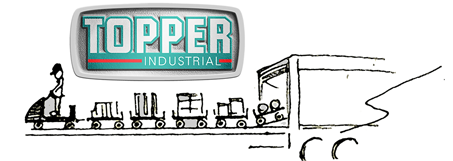Unnecessary movement at the manufacturing cellular level, production working area, is one of the seven wastes and represents a non-value-added loss.
All the movement to bring product to the lines adds time and costs to complete a task; it translates to quantifiable reduced productivity. Walk time is a simple calculation. When labor must walk to retrieve tools, equipment, and components, time and safety are compromised.
The ideal state for a process (value stream) or product should remove or minimize as much waste as possible before closing the project.

Making improvements to the process map to achieve the ideal state is incremental. Saving 25 minutes for each component delivery quickly translates into reduced unnecessary movement, less labor, fewer safety concerns, and improved productivity results.
The other wastes are also impacted with the used of modular flexible solutions including elimination of over production. Too often, due to imprecise product to line sequencing, manufacturers build excess quantity of units more than the customer needs or is willing to pay. The excuse for over production is often blamed on long set-up times, long lead times, and complex assembly. Through synchronized staging, eliminating fork trucks, and carts delivering to flexible modular tubing assembly station the over-production is eliminated.
Manually moving stock to a staging area and dropping off material and picking it back up to deliver to machine is an absurd waste of time. Minimizing the transportation and people involved in moving material is vital in reducing waste on the manufacturing floor. By reviewing transportation waste of any materials (direct or indirect) the TCO (total cost of ownership) for tuggers, carts, and modular tubing can be quickly cost-justified.
Downtime, waiting for parts, components, raw materials, approvals, the previous operation down in a cell, and paperwork represent a significant opportunity to capture lost productivity. A machine or laborer could be waiting for next job, because the current job is being overproduced. Waste is found when a part is waiting for some production element or the people involved are waiting to continue manufacturing product.
Not all inventory is “bad” inventory. A properly sized kanban for each manufactured unit dictates the appropriate inventory at each phase of a value stream. The kanban min/max levels should be dynamic and adjust as conditions change. The dynamic flexibility is matched with modular easily modified tubing staging solutions.
Parts on hand that customer has not purchased yet due to cycle time and lead time represents yet another waste, yet a buffer stock used to offset variation in demand and production is common. The excess inventory ties up cash, creates extra handling, storage, and may never be recovered. This is a critical metric towards improving working capital.
The Topper Tube system includes a wide range of interchangeable tubular components, brackets, castors, and accessories that can be used to create storage racks, carts, trolleys, and workstations adapted and reconfigured as required. This flexibility delivers greater cost effectiveness and lower overall cost of ownership than comparable devices made from welded steel or similar materials. Chris Mosby, a lean expert with Topper Industrial noted, “Beyond selling carts and tubing we offer practical advice how to introduce lean principles to any manufacturing production process ensuring elimination of waste, improve performance, and reduce lead times and lower costs.”


Information submitted by Jillian Burrow, Marketing Manager for Topper Industrial


No Comments Yet!
You can be first to comment this post!